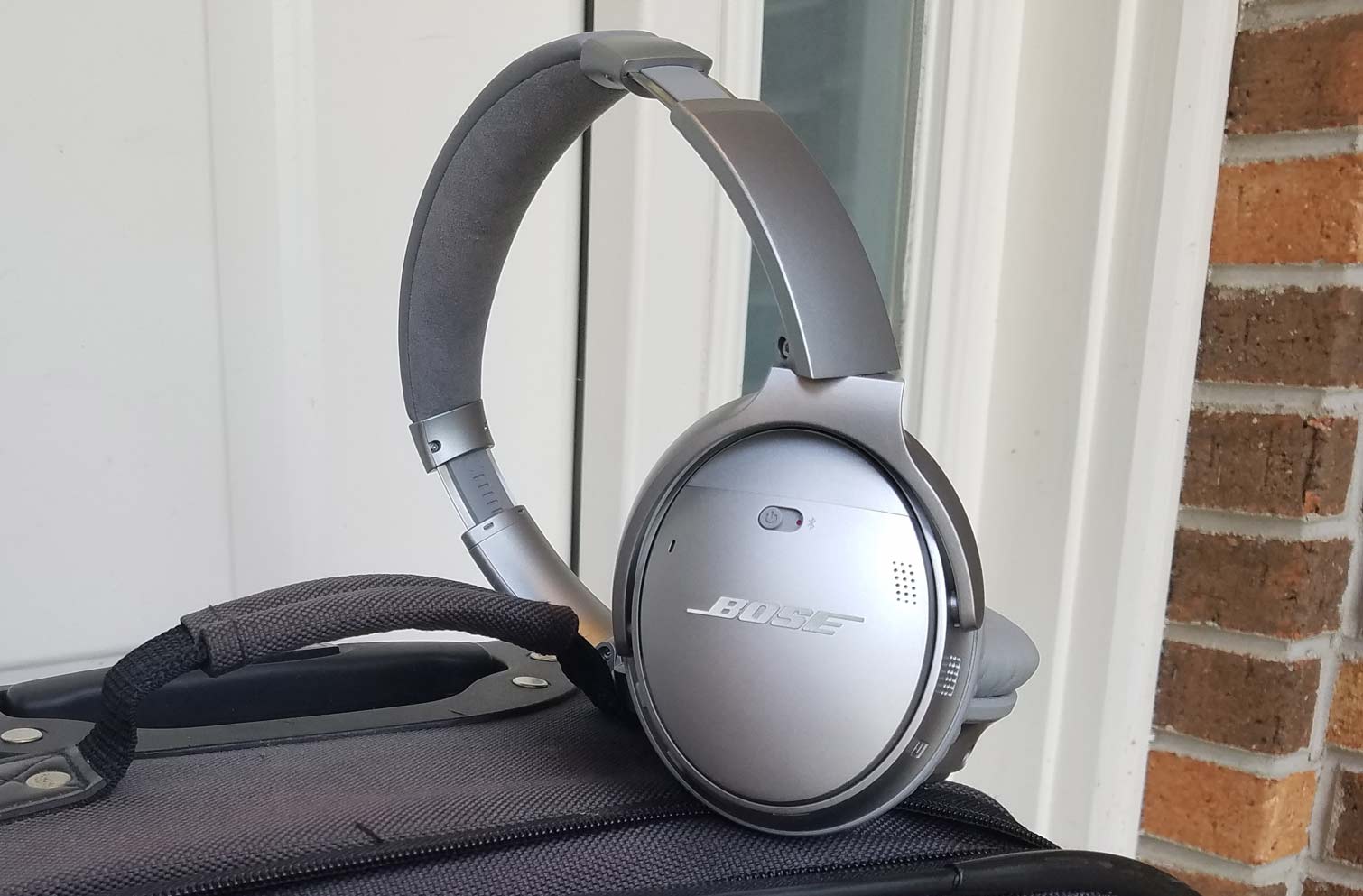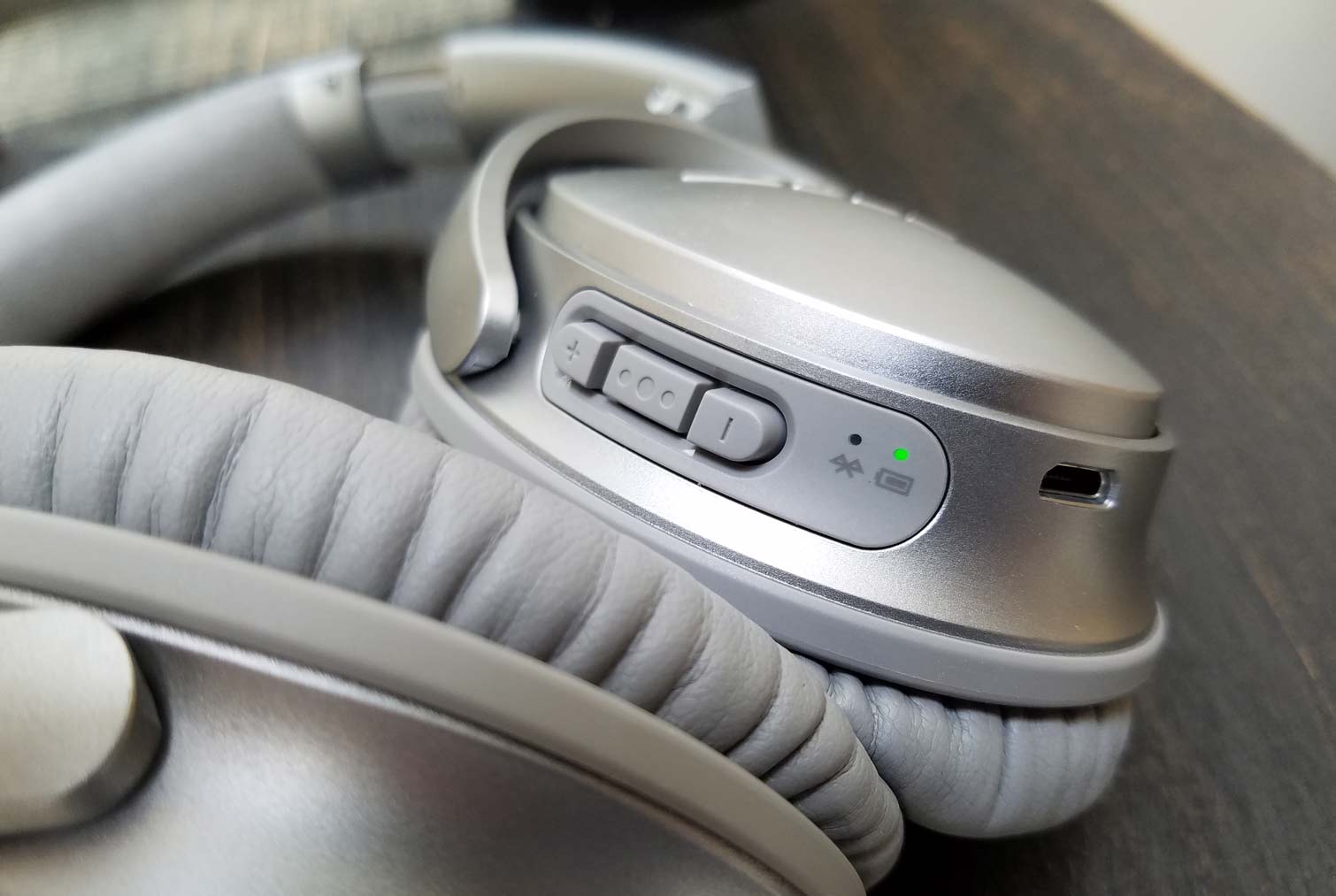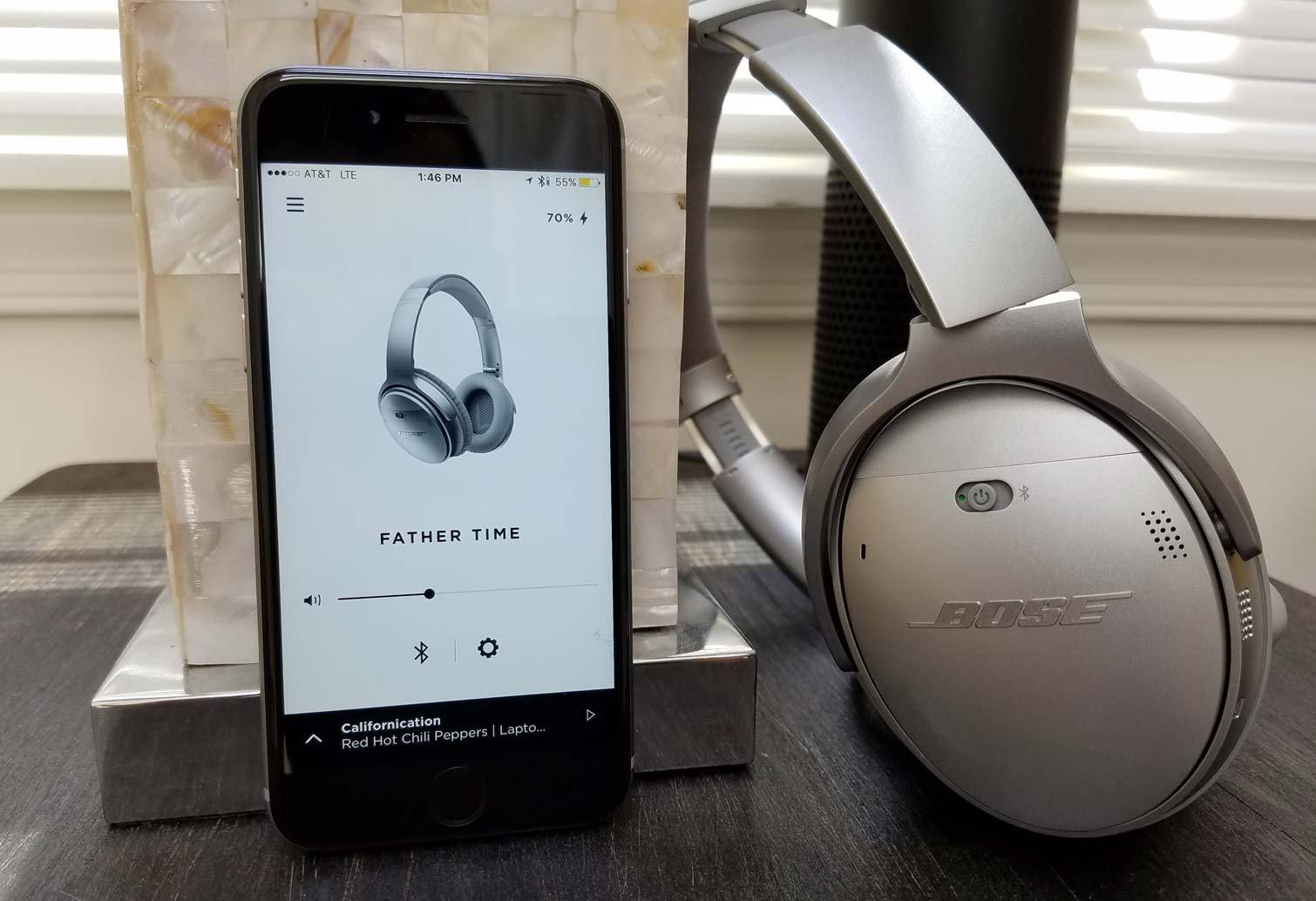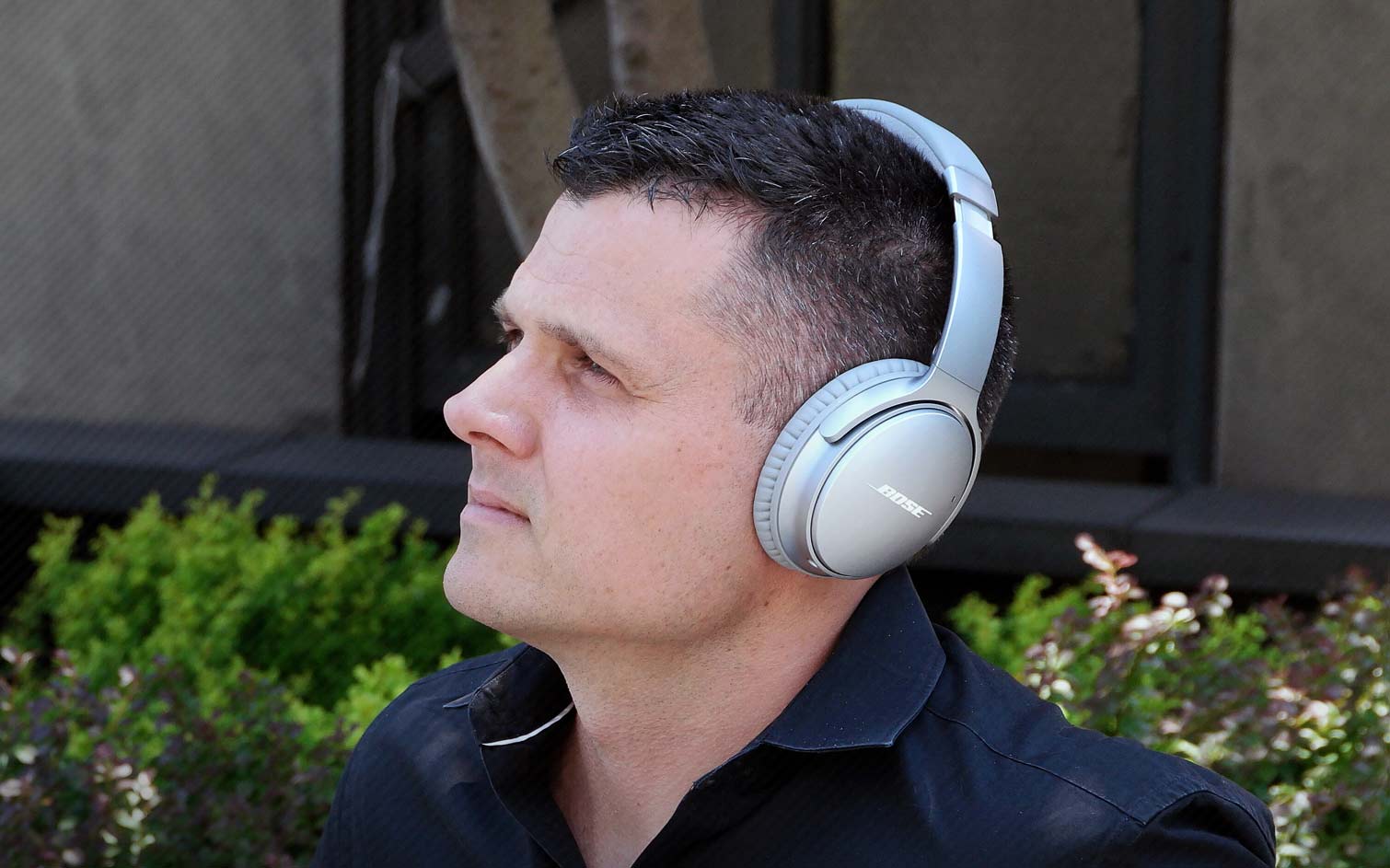Tom's Guide Verdict
The QC35s combine best-in-class noise cancellation with superior audio quality and long battery life, making these the wireless headphones to own.
Pros
- +
Superior noise cancellation
- +
Light and very comfortable wireless design
- +
Intuitive controls
- +
Excellent audio quality
- +
Long battery life
Cons
- -
App doesn't do much
- -
Bass could be beefier
Why you can trust Tom's Guide
As someone who has a 1.5-hour commute to and from work (don't laugh), who flies once a month (or more) on business, and who tries to work from home at least one day a week (with two loud kids), I don't just want noise-cancelling headphones. I need them. But I'm also not a fan of untangling cables at the bottom of my backpack. So when I heard about Bose's QuietComfort 35 ($349), the company's first-ever wireless noise-cancelling headphones, I had to try them. You know what? They're worth every penny, not just because they obliterate racket, but also because they let me hear things I've never appreciated before in my music.

Add in an impressive 20 hours of battery life and a supremely comfortable — if not exactly sexy — design, and you've got the best noise-cancelling headphones money can buy and one of the best gadgets of the year.
A Liberating, Cushy and Slightly Geeky Design
I can't tell you how much I loved not having to deal with wires when using the QC35. There was nothing to untangle from my bag, nothing to catch on someone else on the subway — there was just me and my music.

In fact, I barely noticed that the QC35s were on my head. Measuring 7.1 x 6.7 x 3.2 inches and weighing 10.9 ounces, these headphones are heavier than the wired QC25 (7.5 x 6 x 0.9 inches, 6.9 ounces), but I didn't feel any discomfort after wearing the QC35s for 2 hours straight. The competing Plantronics BackBeat Pro headphones weigh a heavier 11.6 ounces, but the Parrot Zik 3 is a lighter 9.4 ounces.
It helps that the ear cushions on the QC35 are made from a supple synthetic-protein leather that rests gently against your head. Bose also wrapped the headband in Alcantara, a soft material you'll find on yachts.
There was nothing to untangle from my bag, nothing to catch on someone else on the subway — there was just me and my music.
The rest of the headphones consist of a light but tough glass-filled nylon, while the pivots use stainless steel to add rigidity while making it easy to fold up the QC35s into the included carrying case. A micro USB port sits on the bottom right earcup, while the bottom of the left cup has a traditional headphone jack — just in case you run out of juice.

My only issue with the QC35's design is that it's not particularly stylish. The aesthetic says more futuristic air-traffic controller than jet setter. I would order the black instead of the silver model, as the former hue has a more slimming effect. You can't customize the color of the QC35 as you can with the wired QC25, but Bose says more options are coming this fall.
Get instant access to breaking news, the hottest reviews, great deals and helpful tips.
Perfectly Designed Controls
The beauty of wireless headphones is that you don't have to futz with an in-line controller, but going wireless also means you have to find the controls by feel. Fortunately, the buttons and controls couldn't be easier to use.

The bottom of the right earcup houses two chunky, protruding volume buttons and a center pause button that's recessed, which makes sense because you don't want to accidentally stop the music. A double tap lets you skip tracks, which I found easy to do while I walked down Fifth Avenue, and a long press activated Siri on my iPhone.
MORE: Best Headphones and Earbuds for Enjoying Music
It couldn't be easier to pair the QC35 with your phone, thanks to an intuitive switch on the front face of the right earcup. Just push this switch all the way to the right, and the LEDs will start to blink on the headphones; the same switch turns the QC35 on and off.
The QC35 easily juggled being connected with two devices at once, and a somewhat creepy robotic voice can tell you when your phone, laptop or other device reconnects with the headphones.
Bring Me Your Screaming Babies
If you've ever worn mediocre noise-cancelling headphones before, you know that dreaded hiss. It's the sound that's supposed to be nothing but that's really something. You won't hear any of that with the Bose QC35. Bose placed microphones inside and outside the earcups, and these mics work with proprietary chips, one for each ear, to sense noise and then respond with an opposite signal to cancel it out.
The result is an almost eerily silent bliss when you put the QC35s on. During my daily bus ride into New York City, these headphones reduced the incessant rumble of the tires and engine to virtually nothing. By the same token, the QC35s turned my normally screechy subway ride into a pleasant concert for one.

The QC35s were almost too good at times, though, such as when my wife had to tap me on the shoulder to remind me to go pick up the kids. She had been calling my name from a couple rooms away, and I didn't hear a thing.
There's almost eerily silent bliss when you put the QC35s on.
A Different Level of Music Listening
The subtle record scratch in OneRepublic's "I Lived." The wavy guitar reverb that alternated between my ears on The Smiths' "How Soon Is Now." The breaths Bruno Mars takes between verses on "Just the Way You Are." The Bose QuietComfort 35s brought out so many fine details in my Spotify tracks that I couldn't help but smile.
Let's get one thing out of the way, though. True bass-heads should probably look elsewhere. It's not that the QC35s don't deliver a satisfying low end; it's just more punchy than thumpy, as I noticed on Drake and Rihanna's "Too Good." However, Bose's new volume-optimized EQ made the sound so pristine I could easily make out every clack and pop in the background.
On Calvin Harris' "This Is What You Came For," the purposely clipped vocals tickled my ears along with the dance beat, making it easy for me to get lost in the track. The QC35s really soared on Justin Timberlake's "Can't Stop the Feeling," making each snap resonate, and the words "just imagine" happily bounced from right to left, providing a jolt of sonic energy.
The Bose QuietComfort 35s brought out so many fine details in my Spotify tracks that I couldn’t help but smile.
When I turned to harder tracks like Guns N' Roses' "Welcome to the Jungle," the whirlwind scream at the beginning of the track wasn't as ferocious as I'd like, but the jangling guitars balanced well with Axl Rose's penetrating growl. I was never so glad to hear that I'm "going to die."
If you're wondering if Bluetooth wireless negatively affects music playback, it doesn't for the most part. In fact, I noted a wider soundstage on these headphones versus Sony's wired MDR-10RNC, as well as vastly better noise cancelling. However, I did experience a couple of skipped notes over the course of a few days, which could have been due to the connection with my iPhone 6.
Crystal-Clear Calls with a Tiny Caveat
I've never really trusted music headphones for making calls, but the QC35s changed my mind. The dual-mic, noise-rejecting system works as well for voice chats as it does for enjoying music. When I called home while wearing the Bose, my wife couldn't even tell I was a) standing on a busy city street and b) using a headset.
The one strange thing about the experience is that I heard my own voice reverberate during calls, which was distracting at first. Unfortunately, unlike on the Plantronics BackBeat Pro, there's no ambient listening mode, and you can't adjust how much outside audio you let in.
I also liked that I could use the QC35s for accessing Siri, as well as dictating messages. I found that, thanks to the noise-cancelling tech, my transcriptions were more accurate than when I just spoke into my iPhone's mic.
Leave Your Charger Behind
Bose claims that the QC35 lasts for up to 20 hours of wireless listening per charge. After a couple of days' worth of use — which included 3-plus hours of commuting, some phone calls and just rocking out at my desk — the QC35's built-in, rechargeable battery was down to just 70 percent. The Plantronics BackBeat Pros offer a slightly longer 24 hours of juice.
If you decide to go the wired route, the QC35 promises up to 40 hours of endurance.
What's the Point of This App?
The Bose Connect app is so skimpy I'm not quite sure why it exists. It shows you how much battery life is left at a glance, which is nice, but you can get that info spoken in your ear when you put the headphones on.

You can also control the volume from the app, see what song is playing and control playback, but you could already do those things from your phone.
MORE: Best Music Apps for Rocking Out
The only real benefit I see is the ability to set the auto-power-down time (from 5 minutes to 3 hours). I'd like to see an ability to boost the bass or adjust an equalizer, as is offered by Parrot's app for its Zik headphones.
Bottom Line
The best thing I can say about the Bose QuietComfort 35s is that I want them — badly. While they're $50 more than the wired QC25s, I would gladly pay an extra $50 to get Bose's best-in-class noise cancellation in a liberating wireless design. I'm also a big fan of the easy-to-use controls, light and comfy fit, and long battery life. What's not to like? Nothing, unless you have a penchant for heart-pounding bass.
Those on a budget might prefer the $137 Plantronics BackBeat Pros, which last a little bit longer on a charge and also give you the freedom to let in outside audio when you want it. But it's noise cancellation pales to that of the QC35, and the Bose is lighter, too. Overall, the QC35s are the noise-cancellation headphones to beat. I wouldn't leave home, or work from home, without them.
Mark Spoonauer is the global editor in chief of Tom's Guide and has covered technology for over 20 years. In addition to overseeing the direction of Tom's Guide, Mark specializes in covering all things mobile, having reviewed dozens of smartphones and other gadgets. He has spoken at key industry events and appears regularly on TV to discuss the latest trends, including Cheddar, Fox Business and other outlets. Mark was previously editor in chief of Laptop Mag, and his work has appeared in Wired, Popular Science and Inc. Follow him on Twitter at @mspoonauer.
-
Suzuki@1473780084@1473780163 Do they support aptx?Reply
What's the noise cancellation like compared to the QC25?
I might buy these headphones.
Is the 9/10 score and not 10/10 due to sligthtly worse sound, or that hiccup during playback, or what exactly?
You mentioned the Plantronics, and I tried them, and the constant hiss really put me off. Made me wonder if there were any good noise cancelling wireless headphones.
Awesome review! -
Mark Spoonauer Hi Suzuki,Reply
Glad you liked the review. The noise cancellation is just as good if not better than the QC25. I wavered between 9/10 and 10/10 for the rating. They're that good. I wish the design was customizable like the QC25, but that will come later.
It apparently doesn't support Aptx.
thanks
Mark
18156442 said:Do they support aptx?
What's the noise cancellation like compared to the QC25?
I might buy these headphones.
Is the 9/10 score and not 10/10 due to sligthtly worse sound, or that hiccup during playback, or what exactly?
You mentioned the Plantronics, and I tried them, and the constant hiss really put me off. Made me wonder if there were any good noise cancelling wireless headphones.
Awesome review!
-
Peter__ Hi Mark!Reply
Thanks for the review, I agree to most of your points!
I have one issue though: for me the headset is unusable for making calls. The sound for the person on the other end is like using a built in mic of my laptop: all ambient sound is very loud and distracting, even somebody typing on the keyboard in the same room makes my QC35 impossible to use for calls. It does not matter if it is a call via my laptop or via my iPhone. Did you have to configure something?
Thanks
Peter


